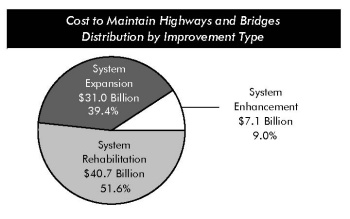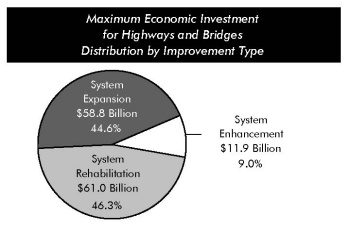
Capital Investment Scenarios: Highways and Bridges
Chapter 7 presents two illustrative future investment scenarios for highways and bridges. The Introduction to Part II (summarized on pages ES-12 and ES-13) includes critical background material required to properly interpret these scenarios. These scenarios assume the continuation of current highway financing mechanisms and current trends in the deployment of certain operations strategies and deployments; Chapter 10 explores the impacts of changing these and other key scenario assumptions.
The average annual Cost to Maintain Highways and Bridges for the 20-year period 2005–2024 is estimated to be $78.8 billion, stated in constant 2004 dollars. This scenario represents the level of investment by all levels of government required to (1) maintain the existing level of bridge deficiencies in constant dollar terms, and (2) keep the physical condition and operational performance of the highway system at a level sufficient to prevent average highway user costs (including travel time costs, vehicle operating costs, and crash costs) from rising above the existing level in constant dollar terms.

Agency costs, such as maintenance, and societal costs, such as emissions, are considered in the benefit-cost analysis for future highway investments, but are not included in the calculation of the maintain user cost performance goal. Taxes are also excluded from the user cost target, since they are not a reflection of system conditions or performance. User taxes would rise under this scenario to cover the additional investment required above 2004 spending levels, so the total costs including taxes experienced by individuals under this scenario would increase.
The average annual Maximum Economic Investment Level for Highways and Bridges for the 20-year period 2005–2024 is estimated to be $131.7 billion, stated in constant 2004 dollars. This scenario represents the level of investment by all levels of government required to implement all cost-beneficial improvements on highways and bridges. This scenario can be viewed as an "investment ceiling" above which it would not be cost-beneficial to invest, even if unlimited funding were available.

System rehabilitation improvements make up 51.6 percent of the Cost to Maintain and 46.3 percent of the Maximum Economic Investment level. This includes all capital investment aimed at preserving the existing highway and bridge infrastructure. System expansion improvements (adding capacity to the system through widening or other means) make up 39.4 percent of the Cost to Maintain and 44.6 percent of the Maximum Economic Investment level. The remaining 9.0 percent of each scenario is not directly modeled; this represents the current share of capital spending on system enhancements such as safety, traffic control facilities, and environmental enhancements.

